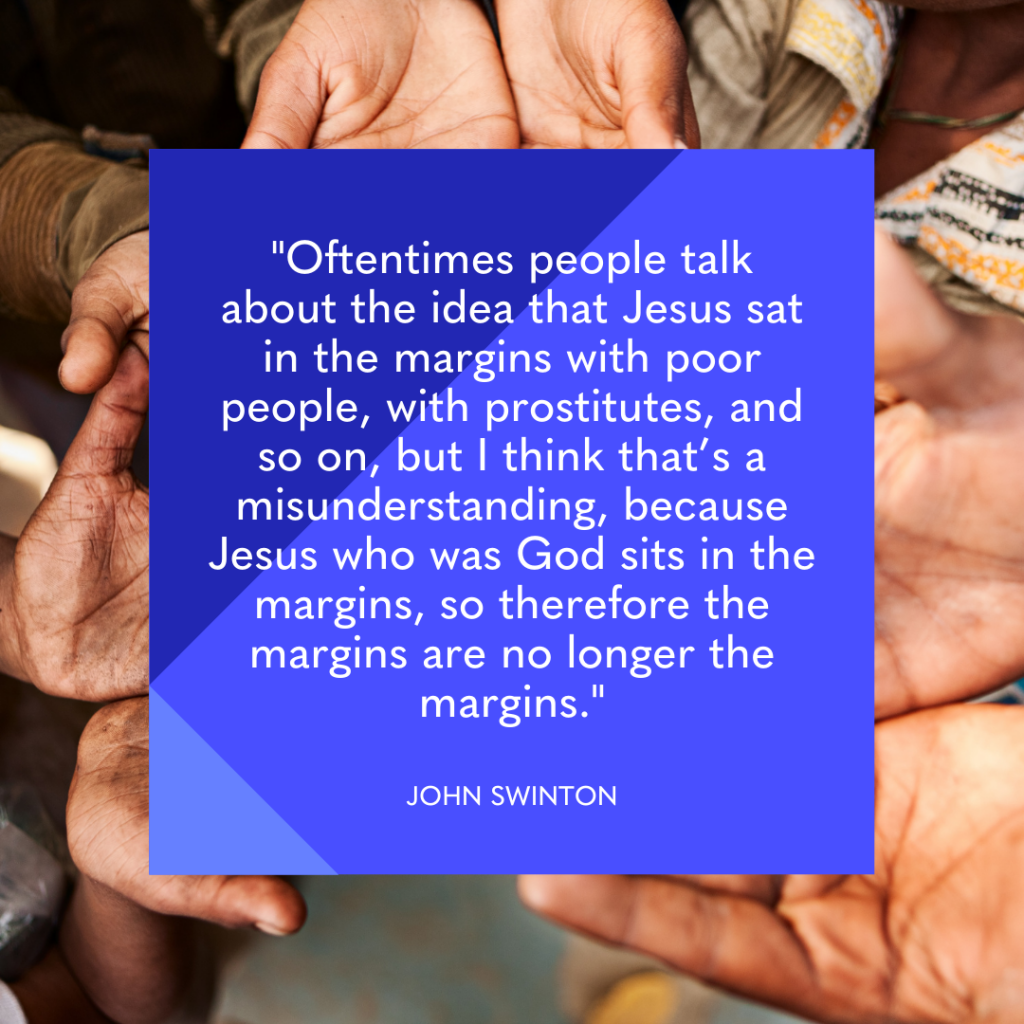Youth Resource
Human Dignity: Disability
The videos, articles, podcast extracts, and suggested activities in this Classroom Resource explore how biblical ideas of universal human dignity and equality impact how Christians, and society in general, treat people living with disabilities.
Videos
-
Disability, inclusion, belonging, and faith
John Swinton on the difference between inclusion and belonging, and the relationship between his faith and work among people with disabilities.
Transcript
SIMON SMART: Now we sometimes think that including disabled people involves putting a ramp in, and a disabled toilet into a building, and thinking that’s enough. But I wonder if you could comment on the difference between inclusion and belonging?
JOHN SWINTON: To be included you just need to be in the place. So you just have to have ramps to let people in, or big prints, or facilities for wheelchairs, or whatever way that you want that to run. And that’s sustained by law and policy, and it’s vital, in that sense, in order that people with disabilities can be in the room, both physically and psychologically. But the problem with inclusion is you don’t have to care. It’s a technical thing – you just have to do it. But to belong, you have to be missed. In other words, to belong you have to have a space that is your own, a space where when you’re not there people long for you, like the prodigal son’s father longs for his son, like God longs for creation to be in some ways. And so creating communities of belonging means that it’s no longer an option for you, it’s no longer a matter of rights and law, you couldn’t imagine it being another way.
SIMON SMART: Have you seen good examples of that for people with disability?
JOHN SWINTON: I’ve seen good examples of it, within which people are clearly integrated; I’ve seen bad examples, where people have clearly been excluded. But actually, the main problem I’ve seen is people in between. So, if I can tell you a brief story: in some of the research we did with people with intellectual disabilities, we came across this woman who was very involved with her local chapel as it was. So, every Sunday she went along to the chapel, and she participated in the worship, participated in the sacrament, and afterwards they had a cup of tea and did their thing. And then she went home, and she didn’t see anybody else until the following Sunday. So she had a series of friendships which lasted for an hour and a half on a Sunday morning.
Now, there’s many people out there, so it’s not specifically to do with that, but that’s not exactly what most people want: a one-and-a-half-hour-long friendship. And so that’s a good example of being included, but not belonging – but also, the congregation, that hadn’t quite noticed, because the congregation thought it was doing alright, and on one level it was. But you want to be able to be visited, to invite people to your house; you want to be invited to other people’s houses, and then you know that you belong.
SIMON SMART: And you want to be missed if you’re not there.
JOHN SWINTON: And you want to be missed if you’re not there, yep.
SIMON SMART: Working with people who, most of our society would see as right on the fringes, what’s it done for you in terms of a faith perspective?
JOHN SWINTON: Well, it’s changed my idea of what the fringes are. Oftentimes people talk about the idea that Jesus sat in the margins with poor people, with prostitutes, and so on, but I think that’s a misunderstanding, because Jesus who was God sits in the margins, so therefore the margins are no longer the margins. And those people over there –
SIMON SMART: That’s where it’s really happening.
JOHN SWINTON: Yeah, those people over there who were engaging in their rituals and so on, they thought they had ownership of God, were actually missing what was going on there. So I think, I’ve always thought, that rather than sitting and being with marginalised people, I’m actually being in a place where I think God is and wants all of us to be in different ways.
SIMON SMART: Well John Swinton, it’s great to have you in Australia, we appreciate you so much coming into CPX, thanks so much.
JOHN SWINTON: My pleasure.
close
Articles
-

Not an inspiration (extract)
Shane Clifton on the problem with ‘inspiration porn’, and the way the Christian story shapes the way he thinks about disability.
-

Baby Gammy and the complexities of moral outrage
In light of the controversy surrounding baby Gammy, Barney Zwartz reflects on surrogacy, disability and double standards.
-

Disability and humanity
Vaughan Olliffe on our ambiguous relationship with disability and the value of every life.
-

A Glorious, Fragile Vision
Simon Smart on what the remarkable story of Dick and Rick Hoyt demonstrates about the value of every human life.
Engage
- Read one of the following news articles – Woman charged after electric wheelchair stolen and then recovered in Adelaide’s west; ‘Hit and miss’: fewer than one in five Australians in disability care vaccinated against Covid-19; Disability photography group providing the tools to share a new perspective; or Reality TV shows Big Brother, The Voice, and The Amazing Race helping to ‘crush’ stigma around disability – and complete the following activities:
- Complete the Word-Phrase-Sentence Thinking Routine for your chosen article. Afterwards, form a group with three other students who read different articles to you, and share your words, phrases, and sentences.
- Select a word from the article that captured your attention or struck you as powerful.
- Select a phrase that moved, engaged, or provoked you.
- Select a sentence that was meaningful to you, that you felt captures the core idea of the article.
- Discuss: what do these articles reveal about the way people with disabilities are treated in our society?
- Complete the Word-Phrase-Sentence Thinking Routine for your chosen article. Afterwards, form a group with three other students who read different articles to you, and share your words, phrases, and sentences.
- Read or watch two other recent news reports that demonstrate something about our society’s treatment of people with disabilities.
- Watch the #WeThe15 campaign video. What stands out to you about this video? What do you think its main message is?
Understand & Evaluate
- Watch the video Disability, inclusion, belonging, and faith and answer the following questions:
- Summarise what John Swinton says about the difference between inclusion and belonging. What are some examples of each?
- What is your reaction to this quote from the video? What does he mean?

- Read the extract from the podcast interview with Shane Clifton.
- Write down two things you learnt or that stood out to you from this interview.
- In the video, Shane says, “So my point would be: just do your best to treat people as people.” How do you think our society’s treatment of people with disabilities would change if everyone practised that?
- Read Barney Zwartz’ article Baby Gammy and the complexities of moral outrage and Vaughan Olliffe’s article Disability and humanity. Complete the Values, Identities, Actions Thinking Routine for the two articles:
- What values do these articles invite us to think about?
- Who are these articles speaking about? And who are they trying to speak to?
- What actions might these articles encourage?
- Read Simon Smart’s article A glorious, fragile vision and answer the following questions:
- How does the story Simon tells make you feel?
- What would you say is Simon’s main point? Do you agree with it?
Bible Focus
- In the podcast extract, Shane Clifton says “It’s interesting to think of Jesus as somehow disabled on the cross.” Read Isaiah 52:13-53:4 (an Old Testament prophecy that Christians see as fulfilled in Jesus). What image do we get of Jesus in this passage? How might this be powerful for people with disabilities?
- Read John 9:1-3 and Luke 5:11-13. What is striking about the way Jesus responds to disability in these passages?
- Read the parable of the great banquet in Luke 14:15-24. What might this story reveal about how God sees people with disabilities?
Apply
- Read the article How young disability activists are using TikTok to make a difference. Create your own TikTok-style video campaign promoting the dignity and equality of people with disabilities, drawing on the ideas explored in this lesson.
- Write a personal journal entry reflecting on the issues explored in this lesson. Which points really resonated with you? What do you want to think about further? What questions or concerns do you still have around this topic?
Extend
- Watch Stella Young’s TED Talk ‘I’m not your inspiration, thank you very much’ that was referenced in the extract of the podcast interview with Shane Clifton. After watching, write a comment to post to YouTube explaining your reaction to the video.


